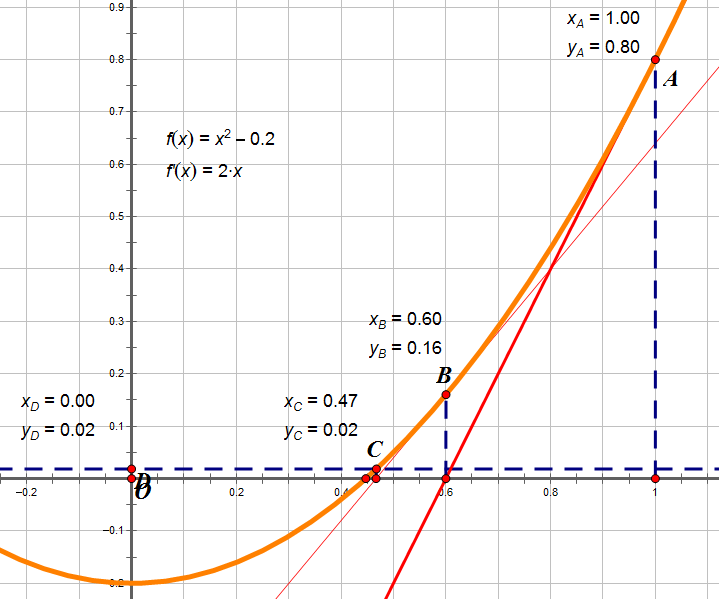在MIT公开课《计算机科学与编程导论》的第五讲中,讲到编写求解平方根的函数sqrt时,提到了牛顿迭代法。今天仔细一查,发现这是一个用途很广、很牛的计算方法。
首先,考虑如何编写一个开平方根的函数sqrt(float num, float e)。参数num是要求开平方根的实数,参数e是计算结果可以达到多大误差。这是一个无法得到精确解,只能求出近似解的问题。该如何编写呢?
1. 传统的二分法
我们可以先猜测一个值作为解,看这个值是否在误差范围内。如果没有达到误差要求,就构造一个更好的猜测值,继续迭代。猜测值可以简单地初始化为num/2,但怎样在下一轮迭代前构造一个更好的猜测值呢?我们不妨参照二分查找算法的思路,解的初始范围是[0, num],用二分法逐渐缩小范围。
private static float sqrt(float num, float e) {
float
low = 0F;
float
high = num;
float
guess, e0;
int
count = 0;
do
{
guess = (low + high) / 2;
if
(guess*guess > num) {
high = guess;
e0 = guess*guess - num;
}
else
{
low = guess;
e0 = num - guess*guess;
}
count++;
System.
out
.printf(
"Try %f, e: %f\n"
, guess, e0);
}
while
(e0 > e);
System.
out
.printf(
"Try %d times, result: %f\n"
, count, guess);
return
guess;
}
在区间[low, high]内取中点(low+high)/2作为猜测值。如果guess*guess大于num,说明猜测值偏大,则在区间[low, guess]进行下一轮迭代,否则在区间[guess, high]中继续。当误差值e0小于能够接受的误差值e时停止迭代,返回结果。
取num=2, e=0.01进行测试,运行结果如下:
Try 1.000000, e: 1.000000
Try 1.500000, e: 0.250000
Try 1.250000, e: 0.437500
Try 1.375000, e: 0.109375
Try 1.437500, e: 0.066406
Try 1.406250, e: 0.022461
Try 1.421875, e: 0.021729
Try 1.414063, e: 0.000427
Try 8 times, result: 1.414063
可见尝试了八次才达到0.01的误差。
2. 神奇的牛顿法
仔细思考一下就能发现,我们需要解决的问题可以简单化理解。
从函数意义上理解:我们是要求函数f(x) = x²,使f(x) = num的近似解,即x² - num = 0的
近似解。
从几何意义上理解:我们是要求抛物线g(x) = x² - num与x轴交点(g(x) = 0)最接近的点。
我们假设g(x0)=0,即x0是正解,那么我们要做的就是让近似解x不断逼近x0,这是函数导数的定义:

可以由此得到

从几何图形上看,因为导数是切线,通过不断迭代,导数与x轴的交点会不断逼近x0。

3. 牛顿法的实现与测试
public
static
void
main(String[] args) {
float
num = 2;
float
e = 0.01F;
sqrt(num, e);
sqrtNewton(num, e);
num = 2;
e = 0.0001F;
sqrt(num, e);
sqrtNewton(num, e);
num = 2;
e = 0.00001F;
sqrt(num, e);
sqrtNewton(num, e);
}
private
static
float
sqrtNewton(
float
num,
float
e) {
float
guess = num / 2;
float
e0;
int
count = 0;
do
{
guess = (guess + num / guess) / 2;
e0 = guess*guess - num;
count++;
System.
out
.printf(
"Try %f, e: %f\n"
, guess, e0);
}
while
(e0 > e);
System.
out
.printf(
"Try %d times, result: %f\n"
, count, guess);
return
guess;
}
与二分法的对比测试结果:
Try 1.000000, e: 1.000000
Try 1.500000, e: 0.250000
Try 1.250000, e: 0.437500
Try 1.375000, e: 0.109375
Try 1.437500, e: 0.066406
Try 1.406250, e: 0.022461
Try 1.421875, e: 0.021729
Try 1.414063, e: 0.000427
Try 8 times, result: 1.414063
Try 1.500000, e: 0.250000
Try 1.416667, e: 0.006945
Try 2 times, result: 1.416667
Try 1.000000, e: 1.000000
Try 1.500000, e: 0.250000
Try 1.250000, e: 0.437500
Try 1.375000, e: 0.109375
Try 1.437500, e: 0.066406
Try 1.406250, e: 0.022461
Try 1.421875, e: 0.021729
Try 1.414063, e: 0.000427
Try 1.417969, e: 0.010635
Try 1.416016, e: 0.005100
Try 1.415039, e: 0.002336
Try 1.414551, e: 0.000954
Try 1.414307, e: 0.000263
Try 1.414185, e: 0.000082
Try 14 times, result: 1.414185
Try 1.500000, e: 0.250000
Try 1.416667, e: 0.006945
Try 1.414216, e: 0.000006
Try 3 times, result: 1.414216
Try 1.000000, e: 1.000000
Try 1.500000, e: 0.250000
Try 1.250000, e: 0.437500
Try 1.375000, e: 0.109375
Try 1.437500, e: 0.066406
Try 1.406250, e: 0.022461
Try 1.421875, e: 0.021729
Try 1.414063, e: 0.000427
Try 1.417969, e: 0.010635
Try 1.416016, e: 0.005100
Try 1.415039, e: 0.002336
Try 1.414551, e: 0.000954
Try 1.414307, e: 0.000263
Try 1.414185, e: 0.000082
Try 1.414246, e: 0.000091
Try 1.414215, e: 0.000004
Try 16 times, result: 1.414215
Try 1.500000, e: 0.250000
Try 1.416667, e: 0.006945
Try 1.414216, e: 0.000006
Try 3 times, result: 1.414216
可以看到随着对误差要求的更加精确,二分法的效率很低下,而牛顿法的确非常高效。
可在两三次内得到结果。
如果搞不清牛顿法的具体原理,可能就要像我一样复习下数学知识了。极限、导数、泰勒展开式、单变量微分等。
4. 更快的方法
在Quake源码中有段求sqrt的方法,大概思路是只进行一次牛顿迭代,得到能够接受误差范围内的结果。
因此肯定是更快的。
float Q_rsqrt( float number )
{
long i;
float x2, y;
const float threehalfs = 1.5F;
x2 = number * 0.5F;
y = number;
i = * ( long * ) &y; // evil floating point bit level hacking
i = 0x5f3759df - ( i >> 1 ); // what the fuck?
y = * ( float * ) &i;
y = y * ( threehalfs - ( x2 * y * y ) ); // 1st iteration
// y = y * ( threehalfs - ( x2 * y * y ) ); // 2nd iteration, this can be removed
#ifndef Q3_VM
#ifdef __linux__
assert( !isnan(y) ); // bk010122 - FPE?
#endif
#endif
return y;
}
{
long i;
float x2, y;
const float threehalfs = 1.5F;
x2 = number * 0.5F;
y = number;
i = * ( long * ) &y; // evil floating point bit level hacking
i = 0x5f3759df - ( i >> 1 ); // what the fuck?
y = * ( float * ) &i;
y = y * ( threehalfs - ( x2 * y * y ) ); // 1st iteration
// y = y * ( threehalfs - ( x2 * y * y ) ); // 2nd iteration, this can be removed
#ifndef Q3_VM
#ifdef __linux__
assert( !isnan(y) ); // bk010122 - FPE?
#endif
#endif
return y;
}
参考文章
Quake3源码中的sqrt
http://www.matrix67.com/blog/archives/362
牛顿迭代方程的近似解
http://blueve.me/archives/369





















 4万+
4万+











 被折叠的 条评论
为什么被折叠?
被折叠的 条评论
为什么被折叠?








